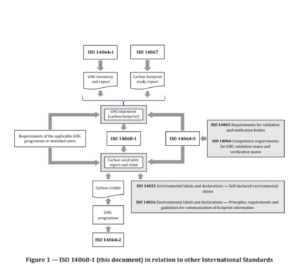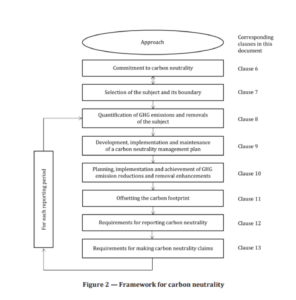ISO 14068-1:2023 Climate change management Transition to net zero Part 1: Carbon neutrality, which was published in November 2023, specifies principles, requirements and guidance for achieving and demonstrating carbon neutrality through the quantification, reduction and offsetting of the carbon footprint.
The standard operates under the umbrella of the ISO Net Zero Guidelines, which were launched at COP27 in Sharm-El Sheikh, Egypt, in November 2022. These principles provide a roadmap for organisations on their journey towards net-zero GHG emissions. The Net Zero Guidelines serve as a reference point for organisations to set net-zero goals and also facilitate the development of standards including the following:
- ISO 14090:2019 Adaptation to climate change
- ISO 14064-1:2018 Greenhouse gases
- ISO 14068-1:2023 Climate change management
The ISO 14060 family of standards provides clarity and consistency for quantifying, monitoring, reporting, validating and verifying GHG emissions and removals and carbon neutrality.
The ISO Net Zero Guidelines (IWA 42:2022) define net zero as “a condition in which human-caused residual greenhouse gas emissions (GHG) are balanced by human-led removals over a specified period and within specified boundaries”. Achieving this balance is a complex process involving emission reductions, offsetting and innovative technologies.
Net-zero emissions can be achieved by reducing emissions at their source and/or through carbon dioxide removal. Emissions reduction is the process of directly cutting emissions of all GHGs. Carbon dioxide removal involves investing in carbon sinks, inter alia, tree planting, soil carbon management, biochar, direct air carbon capture and storage that absorb CO2 from the atmosphere. Offsetting involves an organisation purchasing carbon credits generated by emissions reduction or removal enhancement projects undertaken by another organisation, to neutralise its residual carbon footprint.
ISO 14068-1 builds upon existing ISO standards addressing GHG quantification, reporting, validation and verification such as ISO 14064-1, ISO 14064-3 and ISO 14067. Figure 1 from ISO 14068-1 illustrates the relationship of ISO 14068-1 with other standards within the ISO 14060 family of GHG standards.
Source: ISO 14068-1:2023
The Intergovernmental Panel on Climate Change (IPCC) states that carbon neutrality and net zero CO2 emissions are overlapping concepts which can be applied at the global or sub-global level (e.g., regional, national and sub-national). At the global level the terms are equivalent. At sub-global levels, net zero CO2 typically applies to emissions under the direct control or territorial responsibility of the entity reporting them (e.g., a country, district or sector); while carbon neutrality is also applied to organisations, commodities and activities (e.g., a service or an event) and generally includes emissions and removals beyond the entity’s direct control or territorial responsibility, which are termed scope 3 or value chain emissions. This means the emissions and removals that should be included are wider for neutrality than for net zero goals, but also that offset mechanisms could be employed to help achieve neutrality through abatement beyond what is possible under the direct control of the entity.
ISO 14068-1 provides guidance on the actions necessary to achieve and demonstrate carbon neutrality.
It is applicable to organisations (including companies, local authorities and financial institutions) as well as products (goods or services, including buildings and events).
It establishes a hierarchy for carbon neutrality where GHG emission reductions (direct and indirect) and GHG removal enhancements within the value chain take priority over offsetting. It includes requirements for carbon neutrality commitments and making carbon neutrality claims.
It contains thirteen clauses and four annexes as follows:
Clause 1 Scope
Clause 2 Normative references
Clause 3 Terms, definitions and abbreviated terms
Clause 4 Principles
Application of the principles is essential to ensure that the achievement and demonstration of the carbon neutrality of the subject is undertaken in a true and fair manner, is scientifically and technically valid, and is communicated in an accurate and non-misleading way.
Clause 5 Approach
Figure 2 of ISO 14068-1 defines a framework for achieving and demonstrating carbon neutrality which is further documented in clauses 6 to 13 of the standard. The entity must construct a carbon neutrality pathway that describes its ambition with respect to its trajectory to minimise the carbon footprint of the subject. The carbon neutrality pathway must include short- and long-term targets with specified dates, as well as a target year by which only residual GHG emissions remain, and must be based on a commonly accepted science-based pathway such as SBTi. Carbon neutrality pathways are described in Annex A of the standard.
Source: ISO 14068-1:2023
Clause 6 Commitment to carbon neutrality
The top management of the entity must establish and maintain a commitment to carbon neutrality.
Clause 7 Selection of the subject and its boundary
The entity must identify the subject of the carbon neutrality claim and take into consideration all activities and processes significant to the subject when selecting its boundary. The scope and boundary must be established in accordance with ISO 14064-1 for organisations and ISO 14067 for products (e.g. goods or services, including buildings and events). Annex B of the standard provides requirements for specific subjects.
Clause 8 Quantification of greenhouse gas (GHG) emissions and GHG removals
The entity must identify and quantify GHG emissions and GHG removals of the subject (i.e. its carbon footprint) as defined in ISO 14064-1 for organisations and ISO 14067 for products, as appropriate, or other principles and requirements which are consistent with these standards. For comparative purposes, annexe C provides comparisons between ISO 14064-1 and the GHG Protocol Corporate Standards and between ISO 14067 and the GHG Protocol Product Standard for products.
Clause 9 Carbon Neutrality Management Plan
The entity is required to establish, implement and maintain a carbon neutrality management plan for the subject in accordance with the criteria outlined in clause 9 of the standard.
Clause 10 Greenhouse gas (GHG) emission reductions and GHG removal enhancements
The entity must give priority to reducing GHG emissions within the boundary of the subject by measures such as:
- changes in consumption (e.g. via efficiency gains, eliminating activities, more circular business models).
- application of emission reduction technologies (e.g. end of pipe carbon capture).
- substitution (e.g. to low-carbon materials, electricity or fuels).
Next in the hierarchy, the entity is required to prioritise GHG removal enhancements within the boundary of the subject (e.g. through biological, chemical or physical processes).
Examples of GHG removal enhancements include:
- Forestry.
- Habitat Restoration.
- Ocean fertilisation.
- Ocean alkalinity.
- Enhanced terrestrial weathering.
- Biochar.
- Soil carbon sequestration.
- Bioenergy with carbon capture and storage (BECCS).
Clause 11 Offsetting the Carbon Footprint
If offsetting is needed to achieve carbon neutrality, the entity must purchase and retire carbon credits for the reporting period. Entities cannot claim carbon neutrality using carbon credits that have already been used by another party.
The entity must reduce GHG emissions, and then implement GHG removals within the boundary of the subject before offsetting unabated GHG emissions in line with the carbon neutrality management plan. The reasons for not taking further actions to reduce GHG emissions or enhance GHG removals must be justified and documented.
The entity can only source carbon credits generated from GHG emission reductions or GHG removal enhancements that are real, measurable, permanent, and certified and must be retired within twelve months of the reporting period. The credits must be sourced from carbon credit programmes that satisfy the criteria specified in clause 11.3 of the standard.
Clause 12 Carbon neutrality report
The entity must publish a carbon neutrality report for each reporting period.
Clause 13 Carbon neutrality claims
A carbon neutrality claim can be made only when all requirements of ISO 14068-1 are complied with. A carbon neutrality claim must be based on, and include a reference to, the carbon neutrality report. Carbon neutrality claims must be verified in accordance with ISO 14064-3 or an equivalent verification standard.
Annexe D: Ambition addresses organisations with higher capacity, historical responsibility or high current GHG emissions and who desire to act with higher ambition.
By adopting a net-zero position – i.e., setting a target date to reach net zero, and becoming carbon neutral now – organisations can accelerate the transition to a sustainable future, ensure climate resilience, and create opportunities for innovation, green jobs and economic prosperity for future generations.




